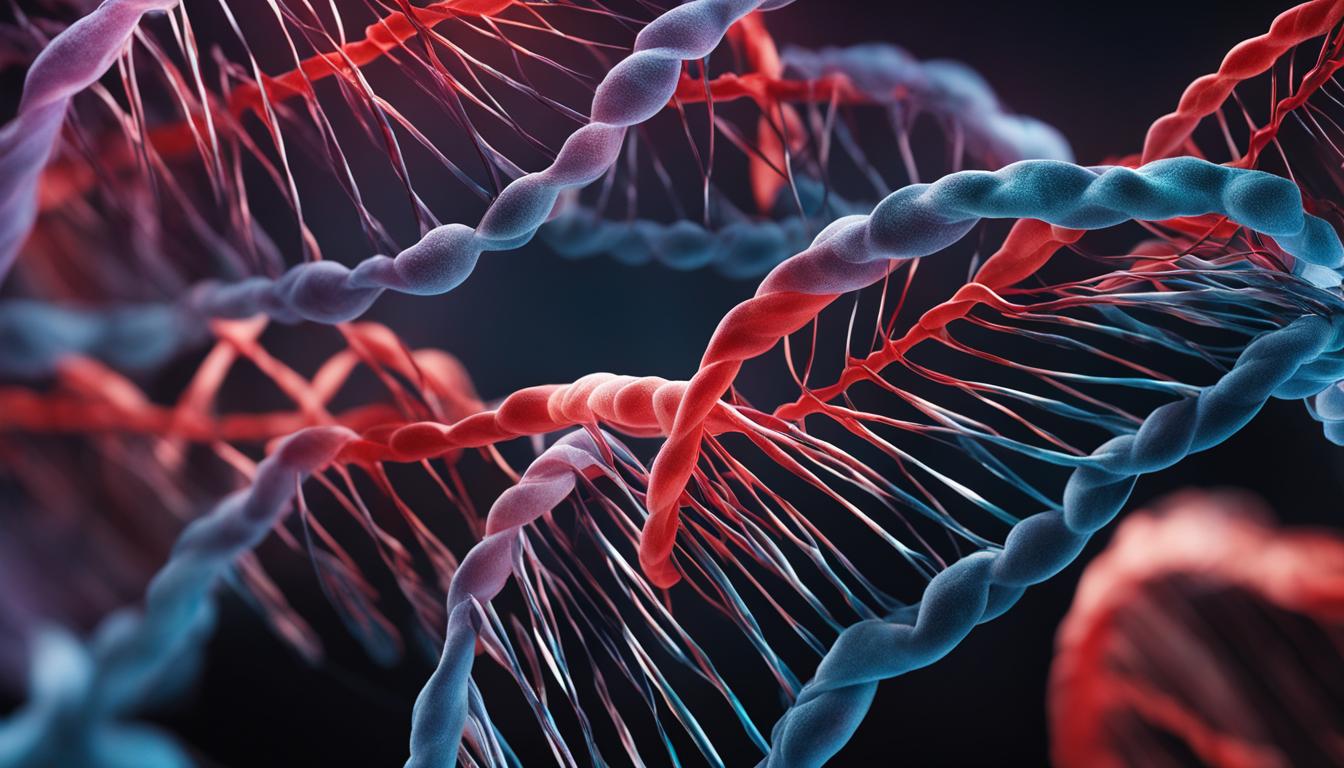Welcome to our in-depth exploration of muscle growth, also known as muscle hypertrophy. In this article, we will delve into the fascinating science behind muscle building, from the intricate processes of protein synthesis to the impact of resistance training. Whether you’re a fitness enthusiast, an athlete, or simply curious about how your muscles grow, this article will provide you with essential insights and knowledge. So, let’s dive in and unlock the secrets of muscle growth science!
Key Takeaways:
- Muscle growth, or muscle hypertrophy, involves increasing the size and strength of muscle fibers through exercise and nutrition.
- Resistance training stimulates muscle tissue, leading to the activation and growth of muscle fibers through protein synthesis.
- There are two main types of muscular hypertrophy: myofibrillar and sarcoplasmic, each with distinct characteristics and benefits.
- Exercise-induced mechanical damage and metabolic fatigue are vital for promoting muscle hypertrophy and growth.
- Training volume, frequency, load intensity, and rest periods are crucial factors influencing muscle growth and should be optimized.
The Types of Muscular Hypertrophy
When it comes to muscle growth, there are two main types of muscular hypertrophy: myofibrillar and sarcoplasmic. Each type has its own characteristics and implications for achieving specific fitness goals.
Myofibrillar Hypertrophy
Myofibrillar hypertrophy focuses on increasing the size and number of myofibrils, which are the contractile units within muscle fibers. This type of hypertrophy is associated with improvements in strength and speed. Through targeted resistance training, such as heavy weightlifting and low-repetition exercises, myofibrillar hypertrophy can be effectively stimulated. This training approach promotes structural changes in the muscle fibers, resulting in increased muscle density and enhanced force production.
Sarcoplasmic Hypertrophy
Sarcoplasmic hypertrophy, on the other hand, involves an increase in the amount of sarcoplasm, the non-contractile fluid and energy stores within muscle cells. This type of hypertrophy is associated with increased muscle glycogen storage and improved endurance. To achieve sarcoplasmic hypertrophy, athletes often focus on high-volume training with moderate weights and higher repetitions. This approach increases the metabolic demands on the muscles, leading to greater glycogen storage and fluid retention in the sarcoplasm, ultimately resulting in increased muscle size and endurance capacity.
It’s important to note that individuals can experience a combination of both myofibrillar and sarcoplasmic hypertrophy to varying degrees, depending on their training methods and genetic factors. Understanding the differences between these types of muscular hypertrophy can help individuals tailor their training programs to achieve their specific goals, whether it’s building strength, increasing muscle size, or enhancing endurance.
The Role of Exercise in Muscle Growth
Exercise plays a crucial role in promoting muscle growth and hypertrophy. When we engage in resistance training, such as weightlifting, we subject our muscles to mechanical damage. This mechanical damage creates micro-tears in the muscle fibers, which then triggers a repair process in the body. The muscle fibers undergo protein synthesis, where new muscle proteins are built to repair and strengthen the damaged fibers. This process leads to muscle growth and hypertrophy.
Additionally, exercise also induces metabolic fatigue in the muscles. As we perform resistance exercises, the muscles deplete their energy stores and accumulate metabolic byproducts. This metabolic fatigue stimulates protein synthesis and the production of growth factors, which further contribute to muscle growth. It is through this combination of mechanical damage and metabolic fatigue that exercise promotes muscle hypertrophy.
Incorporating a variety of resistance exercises, such as compound movements and isolation exercises, can help target different muscle groups and stimulate muscle growth throughout the body. It is important to progressively overload the muscles by gradually increasing the intensity, volume, and frequency of the workouts. This ensures that the muscles are continually challenged and stimulated for growth.
The Role of Rest and Recovery
While exercise is crucial for muscle growth, it is equally important to prioritize rest and recovery. Rest periods between workouts allow the muscles to repair and rebuild stronger. Without adequate rest, the muscles may become overtrained and prone to injury.
During rest and recovery, the muscle fibers adapt to the previous exercise stimulus by becoming stronger and larger. It is during this phase that protein synthesis is maximized, promoting muscle hypertrophy. Getting enough sleep, maintaining a balanced diet, and managing stress levels are also essential for optimal muscle growth.
By combining regular exercise with sufficient rest and recovery, individuals can maximize their muscle growth potential and achieve their desired results.
Factors Influencing Muscle Growth
When it comes to building muscle, several factors come into play that can influence the rate and extent of muscle growth. Understanding these factors and how they interact with each other is crucial for maximizing your muscle-building potential.
One important factor is training volume, which refers to the total amount of exercise performed over a given period of time. Higher training volumes, achieved by increasing the number of sets and repetitions or the overall workload, have been shown to optimize the hypertrophic response and promote muscle growth.
Training frequency is another key factor. It refers to the number of training sessions per week. Split routines that allow for multiple sessions per week targeting specific muscle groups can enhance muscular adaptations and facilitate muscle growth.
The Key Factors:
- Training volume
- Training frequency
- Load intensity
- Rest periods
Load intensity, or the weight lifted during resistance training, is also crucial for muscle growth. Varying the load intensity, from low to high, is recommended to stimulate different types of muscle fibers and promote overall hypertrophy.
Rest periods between sets and exercises play a vital role in muscle growth as well. They allow the muscles to recover and repair, ultimately leading to greater muscle adaptation and growth. Finding the optimal balance between training volume, frequency, load intensity, and rest periods is essential for maximizing muscle growth.
The Role of Genetics in Muscle Growth
Genetics play a significant role in muscle growth and building potential. Each individual has a unique genetic blueprint that determines their muscle-building capacity. Some individuals may have a genetic advantage when it comes to building muscle, while others may face more challenges. However, it’s important to note that genetics only sets the baseline for muscle-building potential and does not limit one’s ability to maximize their own genetic potential through other factors.
Consistent effort, proper training techniques, and a well-rounded lifestyle can help individuals reach their maximum muscle-building potential. While genetics may influence how quickly or easily someone can gain muscle, it does not mean that those with less favorable genetics cannot achieve significant muscle growth and strength improvements. It’s important to focus on the factors that are within our control, such as training, nutrition, rest, and stress management, in order to optimize muscle growth and reach our individual goals.
Maximizing Genetic Potential
Even if someone has less favorable genetics for muscle growth, they can still maximize their genetic potential through targeted training strategies and proper nutrition. Progressive overload, where the muscles are consistently challenged and stimulated to adapt by gradually increasing the training stimulus, is essential for everyone, regardless of their genetic makeup. By gradually increasing training volume, frequency, and load intensity over time, individuals can continue to make progress and achieve their desired muscle growth.
- Include compound exercises in your training routine to target multiple muscle groups simultaneously.
- Focus on high-intensity workouts that maximize muscle fatigue and promote muscle hypertrophy.
- Ensure adequate protein intake to support muscle repair and growth. Aim for lean protein sources such as chicken, fish, tofu, and legumes.
- Get enough rest and quality sleep to allow for proper muscle recovery and repair.
By focusing on these factors and maintaining a consistent, well-rounded approach to training and nutrition, individuals can unleash their genetic potential and achieve impressive muscle growth and strength gains, regardless of their genetic background.

Training Strategies for Muscle Growth
When it comes to optimizing muscle growth, incorporating effective training strategies is key. One such strategy is progressive overload, which involves gradually increasing the stimulus placed on the muscles over time. This can be achieved by progressively increasing the weights lifted, the number of sets and repetitions, or the intensity of the exercises. By challenging the muscles with increasing demands, progressive overload stimulates muscle growth and adaptation.
Another important factor to consider is training volume, which refers to the total amount of exercise performed. To maximize muscle growth, it is essential to ensure that the training volume is sufficient to promote anabolism and stimulate hypertrophy. This can be achieved by performing an adequate number of sets and exercises targeting specific muscle groups.
In addition to training volume, training frequency also plays a crucial role in muscle growth. Finding the right balance between training sessions and rest is important to allow the muscles to recover and repair. Split routines that target different muscle groups on different days can help optimize training frequency and allow for adequate rest and recovery.
Load, or the weight lifted during resistance training, is another important factor in muscle growth. Varying the load intensity, from low to high, helps target different types of muscle fibers and promotes overall hypertrophy. It is important to choose weights that are challenging enough to induce muscle fatigue and stimulate growth.
Rest periods between sets and exercises are also important in muscle growth. Optimal rest periods allow for sufficient recovery and muscle repair. By giving the muscles enough time to recover between sets, individuals can perform each set with maximum effort and intensity, leading to greater gains in muscle size and strength.
Hypertrophy Training Tips:
- Focus on progressive overload by gradually increasing weights or intensity
- Aim for a sufficient training volume to promote anabolism
- Find the right balance between training frequency and rest
- Vary the load intensity to target different muscle fibers
- Optimize rest periods between sets and exercises for adequate recovery
By implementing these training strategies, individuals can maximize their muscle growth potential and achieve their desired results.
Nutrition for Muscle Growth
Proper nutrition is a key component in supporting muscle growth and hypertrophy. One important aspect of muscle growth is protein synthesis, the process by which the body builds new muscle proteins. To promote muscle protein synthesis and support muscle hypertrophy, it is crucial to consume an adequate amount of protein-rich foods.
Lean protein sources, such as chicken, fish, lean meats, and plant-based protein powders, are excellent choices to include in a muscle-building diet. These sources provide essential amino acids that are necessary for muscle repair and growth. Aim to include protein in every meal and snack throughout the day to maintain a steady supply of amino acids for muscle protein synthesis.
In addition to protein, it is important to consume a balanced diet that includes carbohydrates and healthy fats. Carbohydrates provide energy for workouts and help replenish glycogen stores in the muscles, while healthy fats support hormone production and overall health. Including a variety of nutrient-dense foods in your diet will provide the necessary vitamins and minerals to support optimal muscle growth.
Key Points:
- Proper nutrition is crucial for muscle growth and hypertrophy.
- Adequate protein intake is essential to support muscle protein synthesis.
- Include lean protein sources, such as chicken, fish, lean meats, and plant-based protein powders, in your diet.
- Consume a balanced diet that includes carbohydrates and healthy fats to provide energy and support overall health.
- Incorporate a variety of nutrient-dense foods to ensure you’re getting all the necessary vitamins and minerals.

Supplements and Hormones for Muscle Growth
When it comes to maximizing muscle growth, certain supplements and hormones can play a valuable role. While it’s important to note that the foundation of muscle growth lies in proper training strategies and nutrition, supplements and hormones can provide an additional boost to enhance your results.
One popular category of supplements for muscle growth is hypertrophy supplements. These include creatine, beta-alanine, and branched-chain amino acids (BCAAs). Creatine, for example, has been extensively studied and has shown significant benefits in increasing muscle size and strength when combined with resistance training. Beta-alanine can improve muscular endurance, allowing you to push harder during your workouts. BCAAs, on the other hand, can support muscle recovery and reduce muscle breakdown.
Another factor that can influence muscle growth is the use of muscle growth hormones. Hormones such as testosterone and growth hormone naturally occur in the body and play a crucial role in muscle development. However, it’s important to note that the use of hormone supplementation should be done under medical supervision and in compliance with legal regulations.
“Supplements and hormones can provide an additional boost to enhance muscle growth when combined with appropriate training and nutrition.” – Dr. Samantha Johnson, sports nutritionist
While supplements and hormones can be beneficial, it’s important to remember that they are not a magic solution. They should complement a well-rounded approach that includes consistent training, proper nutrition, and adequate rest. Before incorporating any supplements or hormones into your routine, it’s recommended to consult with a healthcare professional or sports nutritionist to ensure they align with your individual needs and goals.

Conclusion
Muscle growth and hypertrophy are fascinating processes that involve a combination of science, hard work, and dedication. Understanding the key factors that contribute to muscle growth, such as resistance training, proper nutrition, and rest, can help individuals achieve their desired results.
One of the fundamental aspects of muscle growth is protein synthesis, where the body builds new muscle proteins to repair and strengthen the damaged muscle fibers. This process is triggered by resistance training, which involves challenging the muscles through exercises like weightlifting.
In addition to resistance training, other factors like training volume, frequency, load intensity, and rest periods play a crucial role in maximizing muscle growth. It’s important to find the right balance in these factors to stimulate muscle hypertrophy effectively.
While proper training and nutrition form the foundation of muscle growth, supplements and hormones can also be used to support the process. Muscle growth supplements, such as creatine and BCAAs, have been shown to enhance muscle size and strength when combined with resistance training. Similarly, natural hormones like testosterone and growth hormone can influence muscle growth. However, it’s important to consult with professionals to use these supplements and hormones responsibly and safely.
By understanding the science of muscle growth and implementing effective strategies, individuals can tap into their muscle-building potential and achieve their goals, whether it’s gaining strength, increasing muscle size, or improving endurance. Remember, consistency and a holistic approach are key to unlocking the power of muscle growth science.
FAQ
What is muscle growth?
Muscle growth, also known as muscle hypertrophy, is the process of increasing the size and strength of muscle fibers through exercise and proper nutrition. It involves stimulating the muscle tissue through resistance training, which leads to the activation and growth of muscle fibers.
What are the types of muscular hypertrophy?
There are two main types of muscular hypertrophy: myofibrillar and sarcoplasmic. Myofibrillar hypertrophy involves an increase in the size and number of myofibrils, which are the contractile units within muscle fibers. Sarcoplasmic hypertrophy refers to an increase in the amount of sarcoplasm, which is the non-contractile fluid and energy stores within muscle cells.
How does exercise contribute to muscle growth?
When we engage in resistance training, such as weightlifting, we create microscopic tears in the muscle fibers. This mechanical damage triggers a repair process in the body, where the muscle fibers are rebuilt to be stronger and larger. Exercise also induces metabolic fatigue, where the muscle fibers exhaust their available energy supply and stimulate protein synthesis, which is essential for promoting muscle hypertrophy and growth.
What factors influence muscle growth?
Several factors influence muscle growth, including training volume, training frequency, load intensity, and rest periods. Higher training volumes and appropriate training frequencies optimize the hypertrophic response. Varying load intensity stimulates different types of muscle fibers. Rest periods between sets and exercises allow for sufficient recovery and muscle repair.
How does genetics affect muscle growth?
Genetics play a significant role in muscle growth and individual differences in muscle-building potential. While genetics set the baseline for muscle-building capacity, individuals can still maximize their own genetic potential through factors like training, nutrition, rest, and stress management.
What are the training strategies for muscle growth?
To optimize muscle growth, it’s important to incorporate specific training strategies, such as progressive overload, sufficient training volume, appropriate training frequency, challenging load, and optimal rest periods. These strategies help stimulate muscle growth and promote recovery.
How does nutrition affect muscle growth?
Proper nutrition is crucial for supporting muscle growth and hypertrophy. Consuming an adequate amount of protein-rich foods supplies the amino acids needed for muscle repair and growth. Lean protein sources, such as plant-based protein powder, lean meat, chicken, and fish, are recommended to support muscle growth.
Do supplements and hormones help in muscle growth?
Certain supplements, such as creatine, beta-alanine, and branched-chain amino acids (BCAAs), have been shown to enhance muscle size and strength when combined with resistance training. Muscle growth hormones, such as testosterone and growth hormone, naturally produced by the body, can also influence muscle growth. However, their use should be done under medical supervision and in accordance with legal regulations.


